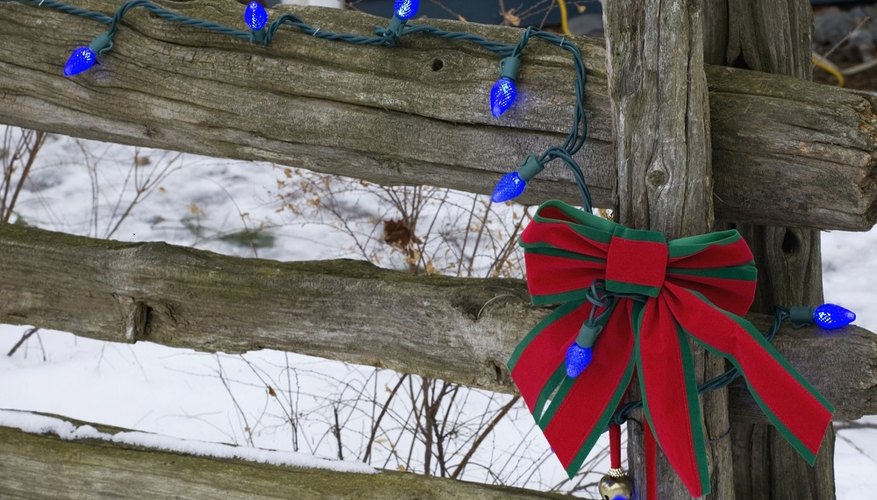Christmas decorations between 1861 and 1864, during the American Civil War, and 1865, the first Christmas after the Civil War, consisted of handmade items, foodstuffs and greenery. Christmas celebrations varied widely, as limited resources challenged Southern families to fashion Christmas decor from next to nothing. Several Christmas concepts sprang from the Civil War, including fixing Santa's address in the North Pole and the tradition, credited to Hans Lauer, of hiding a pickle ornament somewhere in the Christmas tree.
Hardtack ornaments
Mix 300 g (2 cups) flour with just enough water to make a stiff dough.
Roll the dough 1.3 cm (1/2 inch) thick and cut it into squares.
Prick the squares with a skewer, marking a grid or other desirable pattern, such as wheat sheaves, a heart, stars or daisies.
Poke one larger hole at the top of each biscuit so that you can string it later.
Bake the biscuits for 10 minutes at 177 degrees Celsius (350 degrees Fahrenheit), before reducing the oven's temperature to 149 degrees C (300 degrees F) for another 10 minutes. Reduce heat again, to 121 degrees C (250 degrees F), and bake for an additional 20 minutes.
Allow the hardtack to cool overnight, then bake it again at 93.3 degrees Celsius (200 degrees Fahrenheit) for 20 minutes to remove as much remaining moisture as possible.
- Mix 300 g (2 cups) flour with just enough water to make a stiff dough.
- Allow the hardtack to cool overnight, then bake it again at 93.3 degrees Celsius (200 degrees Fahrenheit) for 20 minutes to remove as much remaining moisture as possible.
Cut 25 cm (10 inch) lengths of leather cord or jute twine and thread each biscuit.
Hang the biscuits on a tabletop tree.
Hans Lauer Christmas pickle
Make a Christmas pickle ornament by squeezing a fist-sized piece of self-hardening clay in your palm after rolling it into a cylinder. Pinch and rub the clay until it has bumps like a dill pickle.
Hold the clay pickle in your closed palm while you push a crayon or the eraser end of a pencil into one end to make it hollow, stopping 2.5 cm (1 inch) from the other end.
Poke an ice pick through the solid end of the pickle to make a pair of 3 mm (1/8 inch) diameter holes for stringing.
- Make a Christmas pickle ornament by squeezing a fist-sized piece of self-hardening clay in your palm after rolling it into a cylinder.
- Poke an ice pick through the solid end of the pickle to make a pair of 3 mm (1/8 inch) diameter holes for stringing.
Allow the pickle to dry for three to five days, or until the clay turns white.
Apply three coats of green acrylic paint to the pickle, allowing the paint to dry overnight between coats.
String a ribbon through the holes made by the icepick and hang the pickle deep in the branches of your Christmas tree.
Encourage children to hunt for the pickle and give a small, wrapped, homemade prize to the child who finds it first.
Cut Victorian-themed Christmas cards into hearts, stars or circles, or follow the lines of the main objects or people on the cards.
Punch a hole at the top of each shape. String ribbon through the holes to make hangers.
Cut hearts, stars, doves or angels from brown paper bags or used manila envelopes to create Confederate paper ornaments.
String the ornaments with hemp or jute twine.
Thomas Nast Santas
Make Thomas Nast Santas by tracing the Santa figure from Thomas Nast's "Santa Claus in Camp," originally published in the January 3, 1863 edition of Harper's Weekly, onto shirt cardboard or balsa wood.
Paint or hand-colour Santa's coat and hat royal blue with white stars.
- Make Thomas Nast Santas by tracing the Santa figure from Thomas Nast's "Santa Claus in Camp," originally published in the January 3, 1863 edition of Harper's Weekly, onto shirt cardboard or balsa wood.
- Paint or hand-colour Santa's coat and hat royal blue with white stars.
Paint or hand-colour red and white vertical stripes on Santa's trousers.
Punch or drill a hole at the top of your Santa and string it with red, white or blue satin ribbon.
TIP
While some insist that the practice of hiding a pickle in the Christmas tree was a long-standing German custom long before the American Civil War, Rita Mace Walston's research ascribes it to Bavarian Hans Lauer/John Lower, a Union prisoner in Andersonville, Georgia, who, according to legend, requested a pickle when he thought he was going to die. Once he was freed from prison and returned home, he supposedly started the tradition of hiding a pickle in the Christmas tree with his own family.
